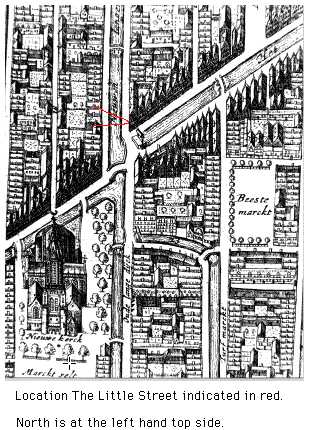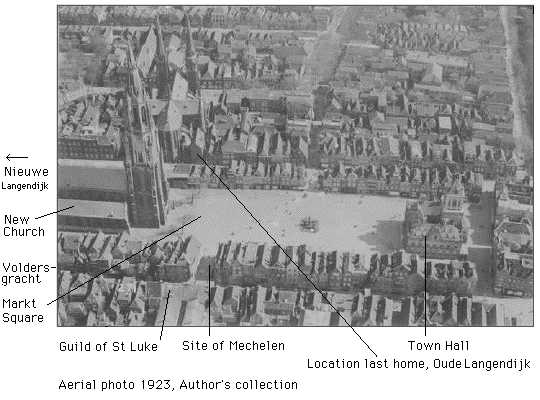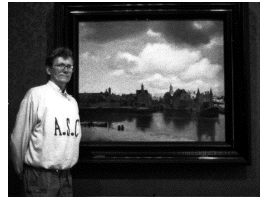Delft Artists Studio workshops
Delft studios are mostly found in streets running from East to West
by Kees Kaldenbach, art historian.
 Generally,
painters prefer northern day light in their studios as that light
changes the least in "colour temperature" from sunrise via high noon
to dusk. This means that the hues and values of painted colours can
be read by the same colour of light all day long.
Generally,
painters prefer northern day light in their studios as that light
changes the least in "colour temperature" from sunrise via high noon
to dusk. This means that the hues and values of painted colours can
be read by the same colour of light all day long.
As most houses in Dutch towns are aligned in such a way that light
only enters the house from the street side or from the garden side,
it follows that the studio would be at either of these two ends of
the house.
In any street which runs from east to
west the northern light can be found on the garden side of the
northern block of houses and at the street side of the southern block
of houses. In Delft this is obvious at such streets as
Choorstraat.
 When
we look at Vermeer's studio in the house on Oude
Langendijk, there are several sources of information. From the
Kaart Figuratief and other sources we know that this building was
long and narrow.
When
we look at Vermeer's studio in the house on Oude
Langendijk, there are several sources of information. From the
Kaart Figuratief and other sources we know that this building was
long and narrow.
We also know about the building's lay-out because of the inventory
made after Vermeer died in 1675. In the inventory made on 29 February
1676 the rooms occupied by Maria Thins, which may have housed a
clavichord or virginal, were not included. Thus we only know of a
part if the lay out.
What we know is this:
There is a voorhuis (front house) large enough to contain
four paintings.
There is a grote zaal (great room) large enough to contain
furniture, household implements, several paintings, household linnens
and woolen cloth, as well as Vermeer's Turkish Mantle and his Civic
Guard implements, being a metal armour and helmet.
Then there is a binnenkeuken (an inner kitchen) large
enough to contain nine paintings, one of which is large, and a good
length of gilt leather wall covering.
There is a op de kelderkamer (a room situated on top of the
cellar) containing various paintings.
There is a voorkamer (front room) in which all of the
painters implements. Thus he used as his studio the room facing the
water of the Oude Langendijk.

In September of 2002 a breathtaking electronic version of
Vermeer's house will be opened exclusively on this web site. It will
contain 3D QuickTime showing a full mockup of the house. This
electronic mockup, crafted by industrial designer
Allan Kuiper has been based (for the
most part) on hard historical evidence.
Architectural plans and elevations will be discussed as well.
These plans have been drawn expressly for this ground breaking
project by Henk Zantkuijl, formerly of
the Delft Polytechnic, the foremost architectural historian in the
Netherlands.
Many household objects mentioned in the 1676 inventory will be
available as well, shown room by room. When objects on the inventory
list are clicked, an image will pop up showing a similar object from
one of the famous Dolls Houses in the
Rijksmuseum or from another historical source. When it comes to
seventeenth century household objects and clothing items no other
historical source is as wonderfully precise and well preserved.
The Rijksmuseum has agreed to
contribute to this project by allowing free access to both the
Rijksmuseum database of photographs and the use of the picture
material.
This page forms part of a large encyclopedic site on Delft. Research by Drs. Kees Kaldenbach (email). A
full presentation is on view at johannesvermeer.info.
Launched 16 February 2009; Last update March 1, 2017. More info in the RKD site.
Advise on the presentation of textiles and clothing have been
kindly provided by the foremost textile historian
Marieke de Winkel.

Thus it has become possible, after some 340 years, to enter into Vermeer's
house and imagine his interior.
 For
more about the author of this home page click author.
For
more about the author of this home page click author.
Email me at kalden@xs4all.nl
Research by Kaldenbach. A
full presentation is on view at www.xs4all.nl/~kalden/. When visiting Holland, join Private Art Tours.
Launched 16 February 2001; last update February 18, 2009.
Thanks to the Delft Archives Staff and the
Amsterdam Rijksmuseum Staff.
 Generally,
painters prefer northern day light in their studios as that light
changes the least in "colour temperature" from sunrise via high noon
to dusk. This means that the hues and values of painted colours can
be read by the same colour of light all day long.
Generally,
painters prefer northern day light in their studios as that light
changes the least in "colour temperature" from sunrise via high noon
to dusk. This means that the hues and values of painted colours can
be read by the same colour of light all day long. When
we look at Vermeer's studio in the house on
When
we look at Vermeer's studio in the house on 
 For
more about the author of this home page click
For
more about the author of this home page click